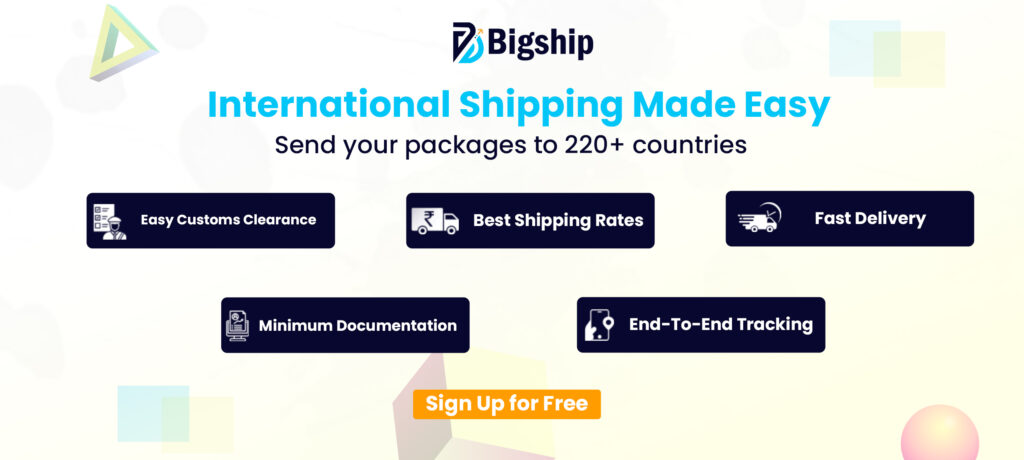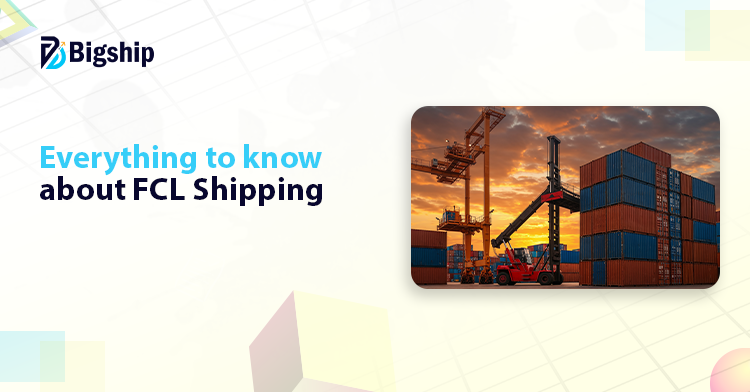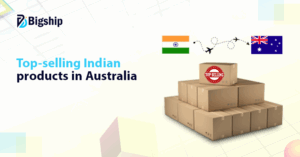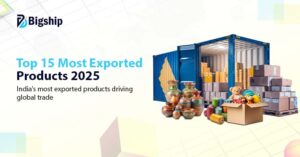In shipping, you may have heard the term full container load or FCL, but still wonder, what is FCL in shipping, and why do businesses choose it? FCL is a method where one shipper books the entire container for their goods. This keeps the cargo safe, direct, and easier to manage. It is often used when the shipment is large enough to fill most of the space.

In this blog, you’ll learn what FCL means, its advantages, disadvantages, documents required, and the step-by-step process of how it works.
What is FCL in Shipping?
FCL in shipping stands for Full Container Load. In this type of shipping method, you use an entire container only for your goods. It can be a 20-foot or 40-foot container based on the size of your cargo. The container is sealed once packed and stays that way until it reaches the final place, and no other shipper shares the space. The FCL full form in shipping itself explains it, a full container load. It is used in international trade when one shipper wants the container for a single use. Since no mixing of goods happens, the cargo moves in a secure and direct way. This makes FCL shipping easy to follow and reliable.
Advantages of FCL shipping
FCL shipping gives you many benefits when you book a full container load. Let’s look at them one by one.
Fixed Cost: In an FCL container, you pay for the whole space. The cost does not change based on how much you fill. This makes planning and budgeting simple.
Faster Movement: Your goods do not wait for other cargo. Once ready, the container moves. This saves time and helps you deliver faster.
Better Security: Only your goods are inside the container. It is sealed at the start and opened only at the end. This lowers the chance of theft or tampering.
Less Damage: Your shipment is handled fewer times. It is not shifted with other cargo. This reduces the risk of damage to fragile or costly items.
Temperature Control: You can choose a reefer container for items that need cold storage. This makes full container load shipping suitable for fresh produce, dairy, or medicines.
Easy Loading and Unloading: The container is packed once at your place and unpacked once at the final point. This keeps the process simple and avoids delays.
Reliable Schedule: Since you don’t depend on other shippers, the timings are more predictable. This helps in keeping your supply chain steady and meeting customer demand.
Disadvantages of FCL shipping
Like every method, full container load shipping also has some drawbacks. You should be aware of them before booking an FCL container.
Higher Cost for Small Loads: You pay for the whole container, even if it is half empty. This makes it expensive for small shipments.
Container Shortage: During peak season, getting an FCL container is not always easy. Shortage or delays can affect your schedule.
Delivery Issues: Unloading a full container needs the right setup. Equipment, dock access, and trained staff are required. Without these, delivery becomes difficult.
Strict Timelines: If your goods are not ready on time, you may lose your slot. Delays in customs or documents can also add pressure.
Possible Delays: Port congestion, customs checks, or transit issues can hold your container. One delay can affect the whole shipment.
Warehouse Needs: You need enough space to store goods before and after shipment. This can be hard for smaller businesses.
Documentation needed for FCL cargo exports
When you ship goods through full container load shipping, proper paperwork is a must. Here are the key documents you need for an FCL container export.
Commercial Invoice: This shows product details, quantity, HS codes, and price. Customs use it to calculate duties and taxes.
Packing List: It explains what’s inside the container. It has box numbers, dimensions, weight, and type of packing. It helps in cargo checks and handling.
Bill of Lading: This is proof that goods are on board. It works as a receipt, a title document, and a contract. You need it to claim the goods at the destination.
Certificate of Origin: This states where the goods were made. It is important for trade deals and to get duty benefits.
Import Permit/ Licence: Some countries need this to allow the entry of goods. It confirms the buyer has the right to import.
Export Declaration/ Shipping Bill: This carries the exporter details, product details, and shipping terms.
Letter of Credit: It assures payment. The bank pays the seller once documents are submitted correctly.
Process of FCL shipping
The process of FCL shipping is simple when you follow each step carefully. Here’s how a full container load shipment works:
Booking the container: The process starts by booking an FCL container with a freight forwarder or shipping line. Here, you need to share details like cargo type, weight, size, and pickup location. The forwarder then arranges the container and transport.
Preparing documents: After booking the container, you must keep all required papers ready. This includes invoice, packing list, bill of lading, and other certificates. Correct and complete documents prevent customs delays.
Loading the cargo: The empty container reaches your location. Now you need to load the goods inside, secure them properly, and seal the container. The seal stays intact until the final delivery.
Moving to the port: The sealed container is transported by truck or rail to the port of origin. The forwarder tracks it and ensures it reaches on time.
Export Customs: At the port, export customs clearance takes place. The forwarder submits your documents and pays duties if required. Once cleared, the container is ready for shipping.
Ocean Journey: The container is loaded onto the vessel. The transit time depends on the shipping route. During this phase, you can track your FCL cargo until it reaches the destination port.
Import Customs: After arrival, the container goes through import customs. The forwarder handles paperwork, duties, and compliance as per local laws.
Final Delivery: Once cleared, the container is moved by truck or rail to the consignee’s location. The seal is opened only at delivery. This completes the FCL shipment process.
Factors Affecting the Cost of FCL Cargo
The cost of full container load shipping depends on many things. These factors are mentioned below:
Container Size and Type: A 40-foot container costs more than a 20-foot one. Special types like reefer or open-top also increase the price because they need extra care.
Distance and Route: Longer routes cost more. Indirect routes or busy ports can add delays and extra charges. Whereas, direct routes are usually cheaper.
Fuel Price: When fuel costs rise, freight charges also go up. Shipping lines often add fuel surcharges to cover this cost.
Port and Terminal Charges: Every port has its own fees for loading and unloading. You may also pay congestion fees or extra charges if there are delays in moving containers.
Demand and Season: During peak seasons like August to November, rates increase. High demand and limited space push up the cost of FCL cargo.
How to Pack Goods in FCL Shipping?
Packing plays an important role in FCL shipping. Since you are using a full container load, the safety of goods depends on how well they are packed and arranged.
Labeling the Cargo: Each box or package should have clear labels. Labels must include product details, weight, and handling instructions. It is better if labeling is done at the factory itself to avoid errors later.
Loading the Container: Packing usually happens at a warehouse or at a Container Freight Station near the port. The goods are checked and cleared by customs before loading. Once cleared, the cargo is placed carefully inside the container.
Arranging the Goods: Heavy items go at the bottom and lighter ones at the top. Use proper packing materials like pallets, straps, and dunnage to keep everything secure. This reduces the chance of damage during transport.
Sealing the Container: After loading, the container is sealed with a high-security seal. The seal stays in place until the shipment reaches the destination.
When to choose FCL in shipping?
You should consider FCL shipping when your cargo volume is large enough to fill most of a container. Also, booking a full container load makes sense if the cost per unit is lower compared to sharing space with others.
It is also the right choice when your goods are fragile, valuable, or need extra security. Since only your cargo is inside, the risk of theft, damage, or mixing with other goods is reduced.
If your shipment requires temperature control or special handling, FCL is often more suitable. It also works well when you want predictable schedules and faster delivery. In short, FCL is best for bulk loads, sensitive cargo, and time-bound shipments.
Shipping FCL cargo with Bigship
Bigship, India’s one of leading courier aggregators, makes FCL shipping simple and easy for you. It helps you book a full container load quickly and without confusion. You can manage all your shipping needs in one place, from booking to delivery. Bigship connects you with 30+ trusted carriers and gives you clear pricing for your FCL cargo. You also get support with documents, customs, and tracking. This means your shipment moves safely from the port of origin to the final destination.
Key Takeaways
- FCL shipping means booking a full container load for one shipper’s cargo.
- Containers usually come in 20-foot and 40-foot sizes for FCL shipment.
- Proper documents like invoice, packing list, and bill of lading are required in FCL shipping.
- FCL shipping charges depend on container size, distance, and seasonal factors.
- Cargo should be packed, sealed, and labeled properly in FCL shipping.
Conclusion
FCL shipping plays an important role in international trade by giving businesses full control of the container. It allows faster delivery, reduced chances of damage, and better cost efficiency for bulk cargo.
igship simplifies the process of full container load shipping by offering reliable services that cover every step of the journey. Businesses can count on Bigship for smooth handling, timely delivery, and complete support in FCL shipments.
So sign up with Bigship and start sending FCL shipments efficiently.
FAQs
What does FCL mean in shipping?
FCL full form in shipping is Full Container Load, where a single shipper uses the entire container for their goods.
How is FCL different from LCL?
In FCL, one container carries only your cargo, while in LCL shipments goods from multiple shippers are combined in the same container.
What documents are needed for FCL shipments?
Important documents include the Bill of Lading, Commercial Invoice, Packing List, and Customs Declaration.





